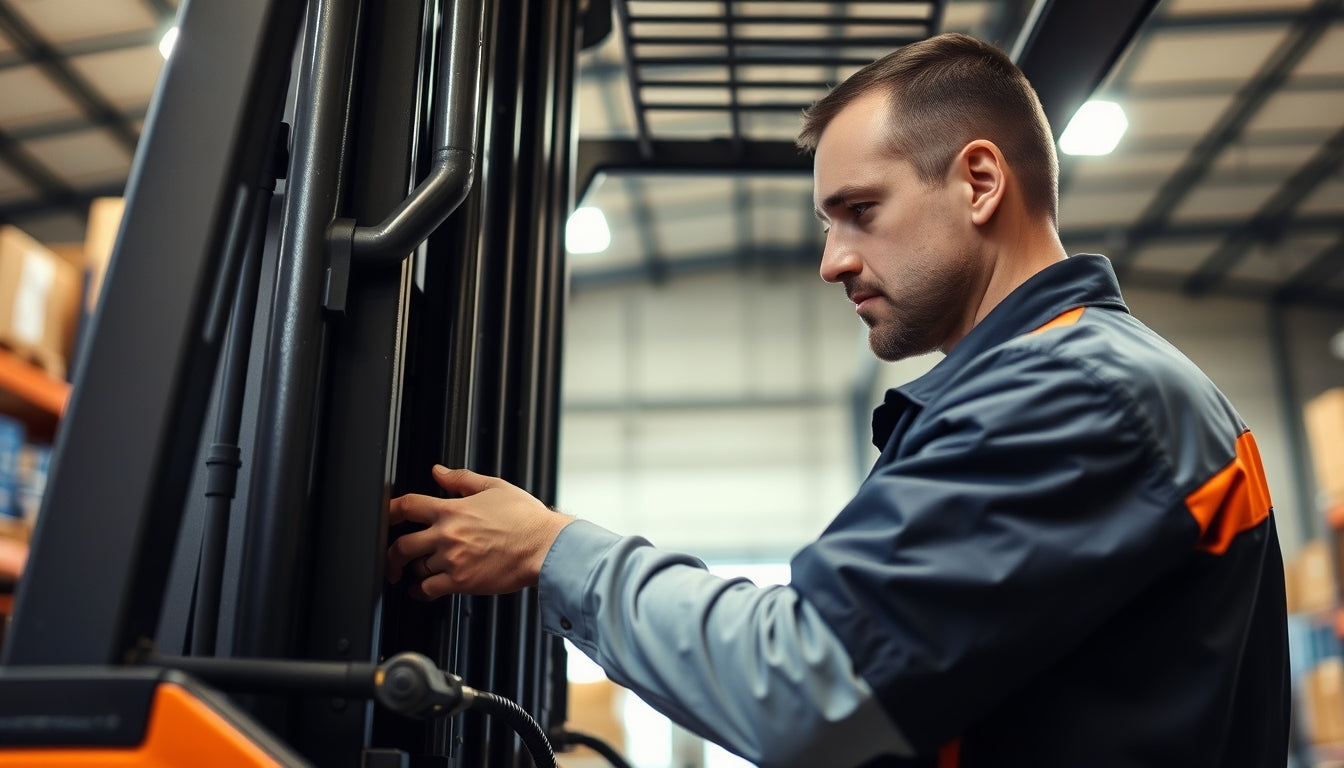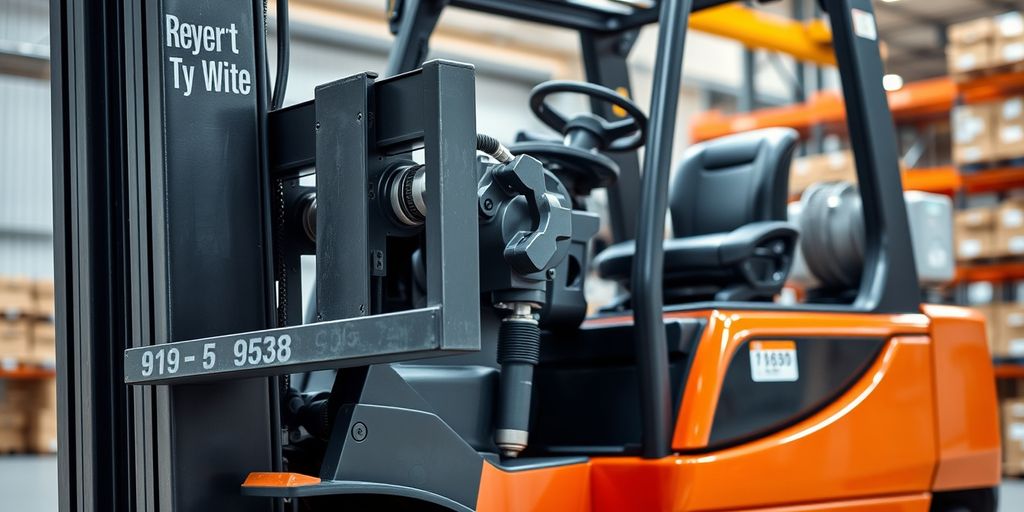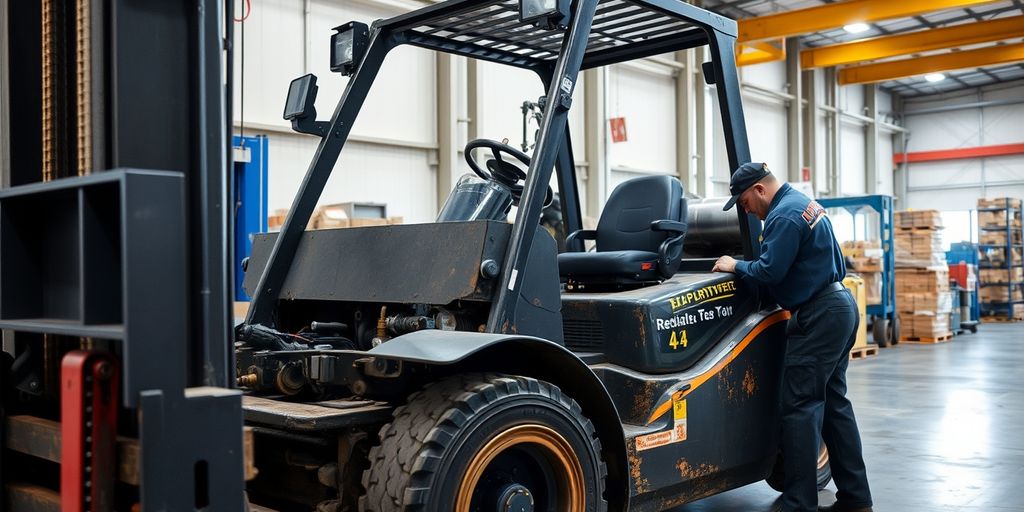Forklifts are essential for many businesses, but keeping them in good shape is crucial. Knowing when to replace parts can save you time and money. This guide will help you understand the signs that parts need replacement, how to inspect them, and tips for preventive maintenance. Plus, we'll discuss the importance of choosing quality parts and proper operator training.
Key Takeaways
- Regularly check your forklift for unusual noises and vibrations to catch issues early.
- Understand the lifespan of critical parts like forks, hydraulic systems, and brakes.
- Use daily, weekly, and monthly checklists to inspect your forklift effectively.
- Preventive maintenance, like regular lubrication and fluid replacements, can extend the life of your forklift.
- Proper operator training is essential for maintaining forklift safety and efficiency.
Signs Your Forklift Parts Need Replacement
Keeping your forklift in top shape is crucial for safety and efficiency. Here are some signs that indicate it's time to replace certain parts of your forklift.
Critical Forklift Parts and Their Lifespan

Keeping your forklift in top shape means knowing when to replace its critical parts. Here's a guide to the key components and their expected lifespans.
Forks and Tynes
Forks and tynes are the most visible parts of a forklift. They typically last around 3 to 5 years, depending on usage. Regular maintenance helps avoid forklift repairs and extends their lifespan. Look for signs of bending or cracks, which indicate it's time for a replacement.
Hydraulic Systems
Hydraulic systems are crucial for lifting and moving loads. These systems can last up to 10,000 hours with proper care. Regularly check for leaks and ensure the hydraulic fluid is clean and at the correct level. Scheduled maintenance is crucial to keep these systems running smoothly.
Brakes and Tires
Brakes and tires are essential for safety. Tires usually need replacing every 2,000 to 3,000 hours, while brakes can last up to 5,000 hours. Inspect tires for wear and tear and check brakes for responsiveness. Frequent breakdowns in these areas can be dangerous and costly.
Batteries and Electrical Components
For electric forklifts, batteries and electrical components are vital. Batteries generally last about 5 years, but this can vary based on maintenance and usage. Proper maintenance is essential to minimize downtime and enhance battery longevity. Regularly check battery water levels and clean terminals to ensure optimal performance.
How to Inspect Forklift Parts Effectively

Daily Inspection Checklist
Performing daily checks is crucial to ensure your forklift operates safely and efficiently. A pre-shift inspection must be done before each use. Here's a simple checklist:
- Look Around: Check the forklift for any damage, leaks, or loose parts. Pay special attention to the mast and tires.
- Fluid Check: Inspect engine oil, transmission fluid, brake fluid, and hydraulic fluid levels. Top them up if needed.
- Battery Check: Ensure battery terminals are clean and tight. Verify the battery is charging correctly.
- Brake Check: Test both the parking brake and service brakes. Listen for any unusual noises.
- Lights and Horn: Test all lights and the horn to ensure they are working.
- Steering: Turn the steering wheel to ensure it moves smoothly. Look for any leaks.
- Forks and Attachments: Measure the height of the forks and check for any damage.
- Seat and Seatbelt: Adjust the seat for comfort and ensure the seatbelt works.
- Controls and Gauges: Check all buttons and gauges for proper operation. Look for any warning lights.
- Load Capacity Plate: Ensure the plate showing the forklift's load capacity is in place and readable.
- Attachments and Accessories: Verify that any additional attachments are securely fastened and functioning correctly.
- Emergency Stop Button: Test the emergency stop button to ensure it works quickly and is easily accessible.
Remember: If you find any problems during the check, tell your boss or the maintenance team straight away. Don’t use the forklift if there are safety issues.
Weekly and Monthly Checks
Weekly and monthly inspections help catch issues that might not be obvious during daily checks. Here's what to look for:
Weekly Checks:
- Look Around: Inspect the entire forklift for loose parts, especially the overhead guard.
- Fluid Check: Look under the forklift for leaks and ensure all fluid levels are adequate.
- Battery Check: Recheck battery terminals and charging status.
- Brake Check: Test the emergency brake and listen for unusual sounds.
- Lights and Horns: Clean and test all lights and horns.
- Steering: Check for steering issues and leaks.
- Forks and Attachments: Measure forks and inspect for damage.
Monthly Checks:
- Hydraulic System: Inspect hoses for damage and ensure smooth mast movement.
- Cables and Chains: Lubricate and check for tightness and straightness.
- Exhaust System: Look for cracks or rust and check emissions.
- Load Backrest Extension: Ensure it is properly attached and undamaged.
- Governor and Accelerator: Verify speed control settings and pedal operation.
- Seat and Seatbelt: Adjust and inspect for wear.
Using Diagnostic Tools
Modern forklifts often come with diagnostic tools that can help identify issues before they become serious problems. These tools can check various systems, including the engine, hydraulics, and electrical components. Check cables and connectors regularly to ensure everything is in good condition.
Professional Inspection Services
While daily, weekly, and monthly checks are essential, professional inspections provide an extra layer of safety. Experts can spot issues that might be missed during routine checks. A professional check should be done annually to ensure your forklift is in top shape. They can also perform load tests and thorough inspections of critical components like the brakes and tires.
Preventive Maintenance Tips for Forklifts
Keeping your forklift in top shape requires regular preventive maintenance. Here are some essential tips to ensure your equipment runs smoothly and efficiently.
Regular Lubrication
Lubrication is crucial for the smooth operation of your forklift. Regularly lubricate all moving parts, including the mast, chains, and gears. This helps reduce friction and wear, extending the lifespan of your equipment.
Timely Fluid Replacements
Fluids such as hydraulic oil, engine oil, and coolant need to be replaced on a regular schedule. Check fluid levels frequently and top them off as needed. Timely fluid replacements prevent overheating and ensure optimal performance.
Proper Cleaning and Storage
Keep your forklift clean to avoid the buildup of dirt and debris, which can cause damage over time. Store the forklift in a dry, sheltered area to protect it from the elements. Proper cleaning and storage practices help maintain the forklift's condition and functionality.
Scheduled Professional Maintenance
While daily and weekly checks are important, professional maintenance should not be overlooked. Schedule regular inspections by certified technicians to identify and address any potential issues before they become major problems. This ensures your forklift remains in excellent working condition.
Preventive maintenance plays a significant role in keeping your forklifts running efficiently. It consists of regular checks and adjustments to ensure all components are in good working order.
Choosing Quality Replacement Parts
OEM vs. Aftermarket Parts
When it comes to replacing forklift parts, you have two main options: OEM (Original Equipment Manufacturer) parts and aftermarket parts. OEM parts are made by the same company that built your forklift, ensuring a perfect fit and reliable performance. On the other hand, aftermarket parts are produced by third-party manufacturers and can vary in quality. While they might be cheaper, they may not always meet the same standards as OEM parts.
Ensuring Compatibility
Before purchasing any replacement part, it's crucial to ensure it is compatible with your specific forklift model. Using parts that don't fit properly can lead to further damage and costly repairs. Always check the part numbers and consult your forklift's manual or a professional to confirm compatibility.
Evaluating Supplier Reputation
Not all suppliers are created equal. It's important to buy parts from reputable suppliers who have a track record of providing high-quality products. Look for reviews and testimonials from other customers to gauge the reliability of the supplier. A good supplier will offer warranties and have a return policy in case the parts don't meet your expectations.
Cost vs. Quality Considerations
While it might be tempting to go for the cheapest option, it's essential to balance cost and quality. High-quality parts might be more expensive upfront, but they can save you money in the long run by reducing the frequency of replacements and minimizing downtime. Investing in quality parts ensures your forklift operates efficiently and safely.
The Role of Operator Training in Forklift Maintenance

Importance of Proper Handling
Proper handling of forklifts by operators is crucial for maintaining the equipment in top shape. When operators are well-trained, they can identify and address minor issues before they become major problems. This not only ensures the safety of the operators but also extends the lifespan of the forklifts.
Training Programs and Certifications
Investing in comprehensive training programs for forklift operators is essential. These programs should cover both the operational aspects and the maintenance requirements of forklifts. Many facilities offer personalized training courses designed around specific equipment, ensuring that all OSHA standards are met. This helps operators understand the importance of regular maintenance and how to perform basic checks.
Daily Maintenance by Operators
Operators should be trained to perform daily maintenance tasks. This includes checking fluid levels, inspecting tires, and ensuring that all safety features are functioning correctly. By conducting these daily checks, operators can help prevent unexpected breakdowns and maintain the efficiency of the forklifts.
Reporting and Addressing Issues Promptly
Encouraging operators to report any issues immediately is vital. A prompt response to maintenance needs can prevent minor issues from escalating into costly repairs. Operators should be aware of the proper channels for reporting problems and should feel empowered to do so without hesitation.
Empowering your operators to learn about regular forklift service will help you keep your forklifts running at peak capacity, so you can continue delivering winning results.
Cost-Benefit Analysis of Forklift Maintenance
Calculating Maintenance Costs
To understand the true cost of maintaining your forklifts, you need to gather some key data. This includes the cost of parts, labor, and any additional expenses. Once you have these numbers, you can use tools like a free forklift maintenance calculator to get a rough estimate. Remember, if your maintenance costs start approaching $4 per hour, it might be time to consider buying a new forklift.
Impact on Operational Efficiency
Regular maintenance can significantly boost your forklift's performance. Well-maintained forklifts experience fewer breakdowns, which means less downtime and more productivity. This not only keeps your operations running smoothly but also helps in meeting production targets consistently.
Long-term Savings
Investing in regular maintenance can lead to substantial long-term savings. By catching small issues early, you can prevent them from turning into major, costly repairs. Additionally, a well-maintained forklift has a longer lifespan, giving you more value for your investment over time.
Regular forklift inspections are essential for safety, performance, and cost savings. They help identify worn components, prevent major repairs, and enhance productivity.
Avoiding Unplanned Downtime
Unplanned downtime can be a major setback for any operation. By keeping up with regular maintenance, you can minimize the risk of unexpected breakdowns. This ensures that your forklifts are always ready to perform when needed, keeping your business running efficiently.
- Lower Costs: Preventive maintenance reduces the need for frequent repairs and lowers the risk of costly downtimes.
- Improved Equipment Life: Consistent upkeep means internal components stay in working order longer, reducing the need for replacements.
- Enhanced Productivity: With fewer disruptions, your operations can continue smoothly, meeting production goals without hiccups.
Conclusion
In summary, keeping your forklift parts in good condition is key to making sure your equipment works well and lasts a long time. Regular checks and maintenance can prevent big problems and keep your forklift running smoothly. By paying attention to the signs that parts need replacing, you can avoid costly repairs and downtime. Remember, a well-maintained forklift is not only safer but also more efficient. So, take the time to care for your equipment, and it will take care of your business.
Frequently Asked Questions
Why is it important to replace forklift parts regularly?
Replacing forklift parts regularly is crucial to keep the equipment running safely and efficiently. It helps prevent accidents, reduces maintenance costs, and ensures compliance with safety standards.
How can I tell if a forklift part needs to be replaced?
Signs that a forklift part needs replacement include unusual noises, decreased performance, visible wear and tear, and frequent breakdowns. Regular inspections can help spot these issues early.
What are some critical forklift parts that have specific lifespans?
Key forklift parts with specific lifespans include forks and tynes, hydraulic systems, brakes, tires, and batteries. Knowing these lifespans helps in planning timely replacements.
How often should I inspect my forklift parts?
Forklift parts should be inspected daily, with more thorough checks weekly and monthly. Using diagnostic tools and professional inspection services can ensure nothing is overlooked.
What is the difference between OEM and aftermarket parts for forklifts?
OEM (Original Equipment Manufacturer) parts are made by the forklift's manufacturer and ensure perfect compatibility, while aftermarket parts are made by other companies and can vary in quality and fit.
How does operator training affect forklift maintenance?
Proper operator training is essential for forklift maintenance. Trained operators handle equipment correctly, perform daily maintenance tasks, and report issues promptly, helping to extend the forklift's lifespan.




Leave a comment
This site is protected by hCaptcha and the hCaptcha Privacy Policy and Terms of Service apply.